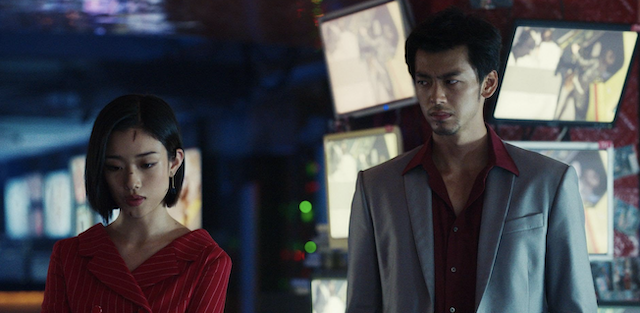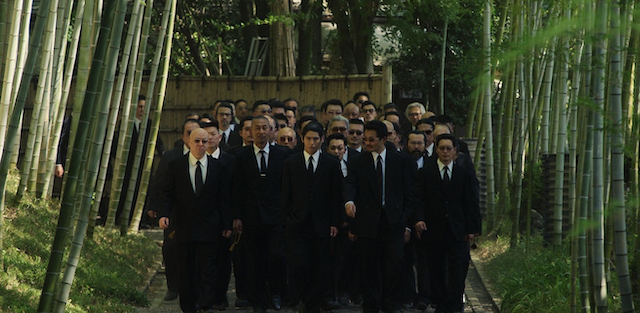
© Amazon MGM Studios
Life is simple for Kazuma Kiryu when he fights in yakuza-sponsored underground fights: keep punching until he is the last man standing. Everything else is much more complicated, because of his complex and sometimes contradictory loyalties to his yakuza clan, their broader criminal alliance, and his adopted family of orphans. Of course, such conflicts do not trouble his fellow yakuza. Despite their sworn oaths, they are really only loyal to themselves. Not surprisingly, many yakuza would be happy if someone finally killed Kiryu (and the feeling is mutual) in co-creators Sean Crouch & Yugo Nakamura’s six-episode Like a Dragon: Yakuza, based on the long-running Sega video game franchise, which premieres today on Prime Video.
After the untimely deaths of their respective parents, Shintaro Kazama “adopted” Kiryu, Yumi Sawamura, Akira Nishiyama, and his sister Miho. Considering themselves sworn-siblings, the four grown Dickensian orphans hatch an ill-conceived scheme to steal from an arcade in territory controlled by Dojima yakuza clan (a powerful subsidiary of the Tojo crime family), who quickly track them back to the orphanage.
Obviously, Kiryu and his friends are in world of hurt, but there might be a saving grace. Much to their shock, Kazama reveals he is a retired Dojima yakuza, who duly begs for their lives. Kiryu also pitches his services to Sohei Dojima, the boss of the Dojima family, to serve as his next “dragon,” hopefully intimidating the clan’s Omi Alliance rivals as their star underground pit-fighter and street enforcer. His model would be the notorious “Devil of Shinjuku,” who periodically reappears to spread terror, hacking down Tojo yakuza and carving pentagrams into their corpses. © Amazon MGM Studios
© Amazon MGM Studios
For most of 1995, their improvised plan largely worked. While Kiryu and Akira Nishiyama scratch their way up the ranks of the Dojima family, Sawamura and Miho Nishiyama work straight hostess jobs in Dojima clubs. It is not optimal for their “sisters,” but it could have been far worse.
However, much has changed in the 2005 timeline. Kiryu has just been released from prison, for a transgressive crime that makes him a pariah amongst his former clan—the details of which will be revealed over time. Miho Nishiyama is also missing, for reasons that will be explained. Still the conscientious one, Sawamura desperately searches for her estranged biological sister Aiko, who vanished along with a stolen shipment of Omi cash, leaving behind her young daughter.
If Kiryu sounds vaguely familiar to non-gamers, it might be from Takeshi Miike’s 2007 film adaptation similarly titled Yakuza: Like a Dragon. Regardless, the Like a Dragon games probably represent one of the most adaptable gaming franchises, because of its strong story component, as well as its street-fighting gameplay action. You will find plenty of both in Prime’s new series.
In fact, many of the fight scenes are spectacularly brutal, especially during the 1995 time-period. Back then, Chairman Dojima is more impressed by the hardness of Kiryu’s head than his martial arts skills, which were somewhat crude. However, the budding yakuza could take a beating, as viewers witness in glorious detail, repeatedly.

© Amazon MGM Studios
Arguably, Like a Dragon represents a rare case where the split time-frame works to the show’s benefit without confusing viewers. Crouch and Nakamura use literal landmarks, like the imposing Kamurocho Tower Chairman Dojima dreams of constructing in 1995 to clearly establish each flashforward or flashback. However, trying to distinguish the various competing families and factions sometimes requires organizational flow charts.
Yet, the large ensemble is uniformly gritty, in ways yakuza genre fans will surely appreciate. Ryoma Takeuchi anchors the film with his massively physical performance as Kiryu. Viewers see him grunt, sweat, brawl, and rage, many times within each episode. Likewise, Kento Kaku is magnetically watchable as the edgy and erratic Akira Nishiyama.
Frankly, it would be hard to decide who won if Masaya Kato, Koichi Sato, and Ryudo Uzaki were competing to be the steeliest, most sinister yakuza boss (repping the Dojima, Tojo, and Omi organizations, respectively). Each chews the scenery with relish and radiates flamboyantly evil vibes. Perhaps the reserved Yuumi Kawai is sometimes overshadowed as the earnest Sawamura, but serious franchise fans will be happy to see her predecessor from Miike’s film, Saki Takaoka return as Reina, the defiant proprietor of a Dojima-controlled hostess club, where she looks appropriately elegant.
Perhaps some viewers might question the believability of Kiryu’s final showdown, but it is important to remember video game logic still prevails throughout Like a Dragon: Yakuza. However, it comes with a great deal of twisty-turny gangster intrigue. The resulting combination delivers a great deal of fun, especially for those who enjoy the yakuza genre conventions. Arguably, it ranks alongside Gangs of London as one of the best and most brutally realistic streaming series adapted from a video game. Highly recommended for fans of the franchise and the yakuza movies that inspired it, Like a Dragon: Yakuza starts streaming today (10/24) on Prime Video.
 © Amazon MGM Studios
© Amazon MGM Studios
Grade: A-
If you like the review, share your thoughts below!
Check out more of Joe’s articles.
Here’s the trailer of the film.

